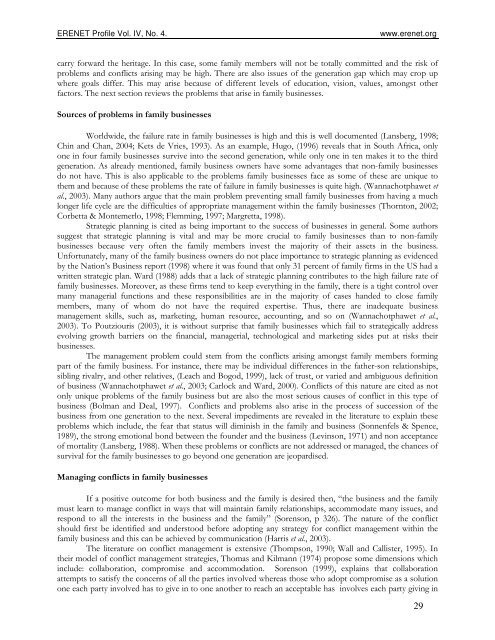Issue 16
Issue 16
Issue 16
You also want an ePaper? Increase the reach of your titles
YUMPU automatically turns print PDFs into web optimized ePapers that Google loves.
ERENET Profile Vol. IV, No. 4.<br />
www.erenet.org<br />
carry forward the heritage. In this case, some family members will not be totally committed and the risk of<br />
problems and conflicts arising may be high. There are also issues of the generation gap which may crop up<br />
where goals differ. This may arise because of different levels of education, vision, values, amongst other<br />
factors. The next section reviews the problems that arise in family businesses.<br />
Sources of problems in family businesses<br />
Worldwide, the failure rate in family businesses is high and this is well documented (Lansberg, 1998;<br />
Chin and Chan, 2004; Kets de Vries, 1993). As an example, Hugo, (1996) reveals that in South Africa, only<br />
one in four family businesses survive into the second generation, while only one in ten makes it to the third<br />
generation. As already mentioned, family business owners have some advantages that non-family businesses<br />
do not have. This is also applicable to the problems family businesses face as some of these are unique to<br />
them and because of these problems the rate of failure in family businesses is quite high. (Wannachotphawet et<br />
al., 2003). Many authors argue that the main problem preventing small family businesses from having a much<br />
longer life cycle are the difficulties of appropriate management within the family businesses (Thornton, 2002;<br />
Corbetta & Montemerlo, 1998; Flemming, 1997; Margretta, 1998).<br />
Strategic planning is cited as being important to the success of businesses in general. Some authors<br />
suggest that strategic planning is vital and may be more crucial to family businesses than to non-family<br />
businesses because very often the family members invest the majority of their assets in the business.<br />
Unfortunately, many of the family business owners do not place importance to strategic planning as evidenced<br />
by the Nation’s Business report (1998) where it was found that only 31 percent of family firms in the US had a<br />
written strategic plan. Ward (1988) adds that a lack of strategic planning contributes to the high failure rate of<br />
family businesses. Moreover, as these firms tend to keep everything in the family, there is a tight control over<br />
many managerial functions and these responsibilities are in the majority of cases handed to close family<br />
members, many of whom do not have the required expertise. Thus, there are inadequate business<br />
management skills, such as, marketing, human resource, accounting, and so on (Wannachotphawet et al.,<br />
2003). To Poutziouris (2003), it is without surprise that family businesses which fail to strategically address<br />
evolving growth barriers on the financial, managerial, technological and marketing sides put at risks their<br />
businesses.<br />
The management problem could stem from the conflicts arising amongst family members forming<br />
part of the family business. For instance, there may be individual differences in the father-son relationships,<br />
sibling rivalry, and other relatives, (Leach and Bogod, 1999), lack of trust, or varied and ambiguous definition<br />
of business (Wannachotphawet et al., 2003; Carlock and Ward, 2000). Conflicts of this nature are cited as not<br />
only unique problems of the family business but are also the most serious causes of conflict in this type of<br />
business (Bolman and Deal, 1997). Conflicts and problems also arise in the process of succession of the<br />
business from one generation to the next. Several impediments are revealed in the literature to explain these<br />
problems which include, the fear that status will diminish in the family and business (Sonnenfels & Spence,<br />
1989), the strong emotional bond between the founder and the business (Levinson, 1971) and non acceptance<br />
of mortality (Lansberg, 1988). When these problems or conflicts are not addressed or managed, the chances of<br />
survival for the family businesses to go beyond one generation are jeopardised.<br />
Managing conflicts in family businesses<br />
If a positive outcome for both business and the family is desired then, “the business and the family<br />
must learn to manage conflict in ways that will maintain family relationships, accommodate many issues, and<br />
respond to all the interests in the business and the family” (Sorenson, p 326). The nature of the conflict<br />
should first be identified and understood before adopting any strategy for conflict management within the<br />
family business and this can be achieved by communication (Harris et al., 2003).<br />
The literature on conflict management is extensive (Thompson, 1990; Wall and Callister, 1995). In<br />
their model of conflict management strategies, Thomas and Kilmann (1974) propose some dimensions which<br />
include: collaboration, compromise and accommodation. Sorenson (1999), explains that collaboration<br />
attempts to satisfy the concerns of all the parties involved whereas those who adopt compromise as a solution<br />
one each party involved has to give in to one another to reach an acceptable has involves each party giving in<br />
29
















